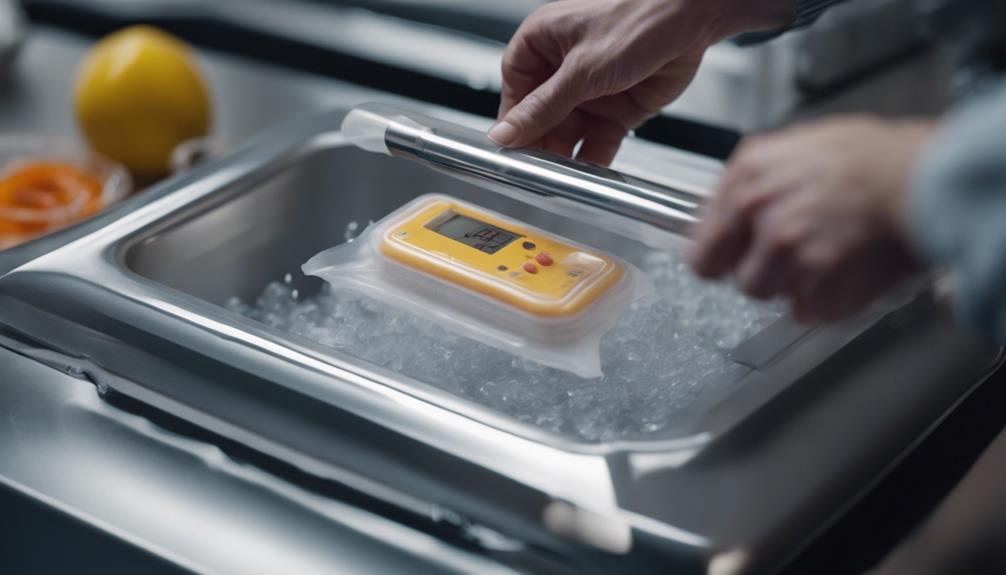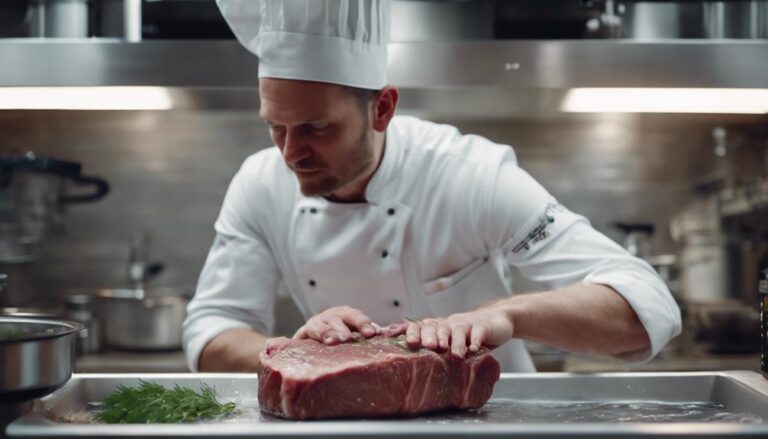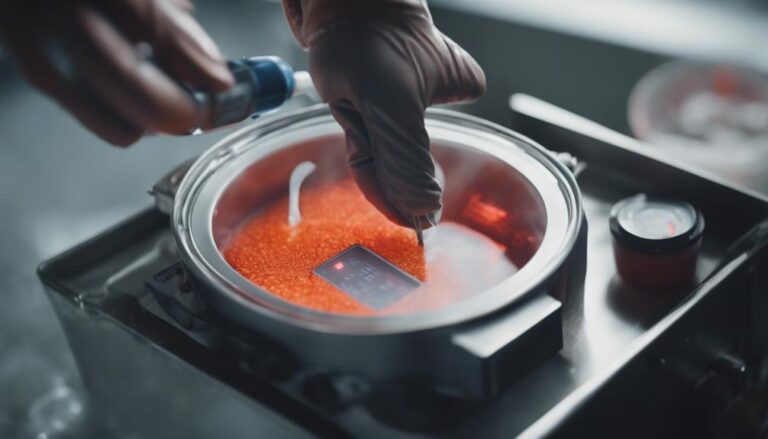10 Best Tips for Safe Sous Vide Cooking
Guarantee safe sous vide cooking: utilize food-grade bags, pasteurize thoroughly, refrigerate perishables promptly, avoid cross-contamination, and monitor temperatures with a food thermometer. Adhere to suggested cooking times, seal bags appropriately, and clean equipment thoroughly. Store sous vide tools securely. Additional tips are available for improving your sous vide experience.
What You Will Learn Here
- Use BPA-free, food-grade vacuum-sealed bags for safety and flavor preservation.
- Ensure precise pasteurization to eliminate harmful bacteria, especially for vulnerable individuals.
- Monitor water bath temperature with a thermometer for accurate cooking.
- Refrigerate perishables promptly and store below 40F to prevent bacterial growth.
- Clean and sanitize equipment regularly to maintain hygiene and prevent contamination.
Use Food-Grade Vacuum-Sealed Bags
For important and high-quality sous vide cooking, choose food-safe vacuum-sealed bags that are specifically designed for this cooking method. These specialized bags are BPA-free, guaranteeing that no harmful chemicals leach into your food during the cooking process. By using vacuum-sealed bags approved for sous vide cooking, you create a protective barrier against contaminants, maintaining the integrity of your ingredients. These bags not only help in preserving flavors, textures, and nutrients but also contribute to the overall safety of your cooking process.
When selecting sous vide bags, prioritize quality and safety. Opt for bags that are explicitly labeled as food-safe and suitable for vacuum-sealing to guarantee the best results. By investing in the right type of bags, you make sure that your sous vide cooking experience isn't only delicious but also free from any potential health risks associated with using improper materials. Remember, the choice of sous vide bags plays an important role in achieving the desired outcome, so always prioritize using the correct ones for your culinary creations.
Ensure Proper Pasteurization
Proper pasteurization in sous vide cooking is essential for ensuring food safety and minimizing the risk of foodborne illnesses. Sous vide cooking involves cooking food at precise temperatures for specific durations to achieve pasteurization. Pasteurization times vary depending on the type of food and the desired doneness. For example, beef needs to reach temperatures between 130F to 145F, while chicken requires temperatures ranging from 140F to 150F to guarantee safety. It's important to follow pasteurization guidelines carefully to make sure that all harmful bacteria are eliminated.
When cooking blade-tenderized steaks or low-quality fish, it's critical to extend pasteurization times for health precautions. Proper pasteurization is especially important when serving individuals with compromised immune systems. By understanding and adhering to pasteurization guidelines, you can reduce the risk of foodborne illnesses during sous vide cooking. Remember, maintaining the correct temperature for the designated cooking times is key to achieving safe and delicious results.
Refrigerate Perishable Items Promptly
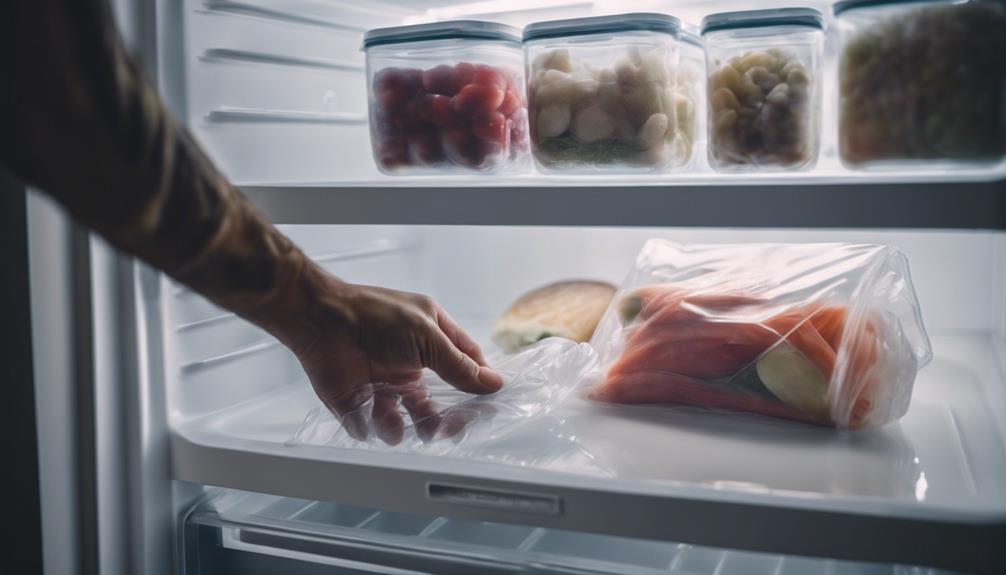
Refrigerate raw meat, poultry, and seafood promptly after purchase or preparation to prevent bacterial growth. Keeping perishable items like these in the refrigerator within 2 hours is important for maintaining food safety during sous vide cooking. Store them in the coldest part of the fridge at a temperature below 40F (4.4C) to guarantee freshness and reduce the risk of bacteria growth. Using a refrigerator thermometer to monitor the temperature consistently is vital, as temperatures above 40F (4.4C) can lead to spoilage.
Avoid leaving perishable items out at room temperature for too long, especially when planning to use them for sous vide cooking. If you're unsure about the freshness of any perishable items, it's best to discard them rather than risking food safety issues.
Avoid Cross-Contamination
To guarantee safe sous vide cooking, you must:
- Clean your work surfaces diligently.
- Use separate utensils for raw and cooked foods.
- Sanitize food containers thoroughly.
By following these practices, you can prevent cross-contamination and minimize the risk of foodborne illnesses in your kitchen.
Make it a habit to prioritize hygiene and maintain a clean cooking environment for safe and enjoyable sous vide cooking experiences.
Clean Work Surfaces
To maintain a safe cooking environment, make sure that your work surfaces are cleaned with hot, soapy water both before and after preparing sous vide ingredients to prevent cross-contamination.
When you cook sous vide, cleanliness is vital to guarantee the safety of the food you serve. By washing your work surfaces thoroughly, you reduce the risk of harmful bacteria transferring to your ingredients. Cleaning your surfaces before and after handling food helps maintain a hygienic cooking area, minimizing the chances of cross-contamination.
Prioritize the cleanliness of your cooking space to uphold the quality and safety of your sous vide dishes. Remember, a clean environment is essential when cooking sous vide to protect yourself and those you're serving.
Use Separate Utensils
For optimal food safety in sous vide cooking, make sure you use separate utensils for raw and cooked ingredients to prevent cross-contamination. Assign specific utensils for handling raw foods and a different set for cooked sous vide dishes. It's important to avoid using the same tongs, knives, or cutting boards for both raw and cooked items to maintain food safety.
Consider implementing color-coded utensils or labels to easily distinguish between tools for raw and cooked foods when using sous vide equipment. Remember, cross-contamination can lead to foodborne illnesses, so taking this extra step of using separate utensils is essential for ensuring the safety of your sous vide cooking.
Sanitize Food Containers
When maintaining food safety in sous vide cooking, ensuring that you sanitize food containers is essential to avoid cross-contamination.
Here are some tips to help you keep your food containers clean and free from harmful bacteria:
- Wash with hot, soapy water: Clean your plastic containers with hot, soapy water before and after each use to prevent bacterial growth.
- Use food-safe sanitizing solutions: Consider using food-safe sanitizing solutions or diluted bleach to eliminate any harmful bacteria effectively.
- Inspect for wear and tear: Regularly check your containers for signs of wear or damage that could harbor bacteria, ensuring they remain safe for use.
Use a Food Thermometer
Make sure to use a food thermometer to keep track of the temperature in your sous vide water bath accurately.
Confirm that your immersion circulator is working correctly by double-checking with a reliable food thermometer.
Ensuring your food reaches and maintains the essential cooking temperature is crucial for eliminating harmful bacteria and keeping your cooking safe.
Temperature Accuracy
For accurate and secure sous vide cooking, rely on a high-quality food thermometer to confirm the precision of your cooking temperature. Here are some tips to guarantee temperature accuracy:
- Verify Temperature: Use a food thermometer to check that the water temperature matches the set temperature on your sous vide machine.
- Monitor Consistently: Periodically check the thermometer during cooking to maintain a consistent and safe temperature environment.
- Calibrate Regularly: Calibrate your food thermometer frequently to ensure precise temperature readings for safe sous vide cooking.
Investing in a reliable food thermometer is essential for precise temperature control and ensuring food safety in your sous vide cooking endeavors.
Probe Placement
To guarantee accurate monitoring of food temperature in sous vide cooking, strategically place the food thermometer in the thickest part of the food item. Using a food thermometer is essential to confirm the accuracy of the immersion circulator's temperature readings. Placing the thermometer correctly ensures you get the most precise temperature reading, preventing undercooking or overcooking your food.
Be mindful not to place the thermometer too close to the edge of the bag or in contact with it, as this can lead to inaccurate readings. Checking the temperature at different points in the water bath helps ensure uniform heat distribution around the food being cooked.
Monitor Cooking Temperatures Closely

To guarantee precise temperature control and uphold food safety, routinely verify the circulator temperature with a second thermometer while cooking sous vide. This practice ensures accuracy, especially during extended cooks, where maintaining the right temperature is critical to prevent bacterial growth.
Here are some essential tips to help you monitor cooking temperatures closely:
- Regular Temperature Checks: Take a moment to check the circulator temperature with a second thermometer periodically. This simple step can prevent temperature discrepancies and make sure your food is cooking safely.
- Maintain Accuracy: Keep a close eye on the temperature range between 130F (54.4C) and 40F (4.4C) to inhibit bacteria growth effectively. Monitoring this range helps uphold food safety standards.
- Safety First: Remember to cook a degree or two above the danger zone for extended cooks, as an extra precaution to safeguard against any potential risks to food safety.
Follow Recommended Cooking Times
Guarantee precise cooking results by following the suggested cooking times customized to each specific food item when engaging in sous vide cooking. Different foods have varying requirements to ensure both safety and doneness.
By adhering to recommended cooking times, you can prevent the risks associated with undercooking or overcooking your meals. Overcooking may lead to a less desirable texture, while undercooking poses potential health risks.
It's essential to consult sous vide charts for accurate cooking times based on the type of food and its thickness. Properly timing your sous vide cooking not only enhances food safety but also ensures the best taste and texture for a delightful dining experience.
Seal Bags Properly Before Cooking
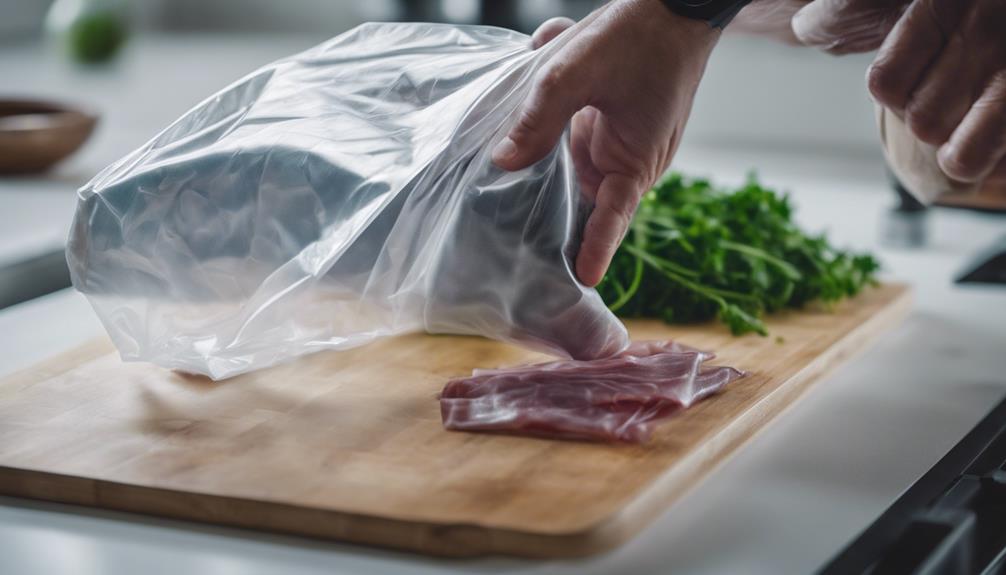
Before you begin your sous vide cooking, make sure you seal the bags properly. This step is essential to prevent water leakage and maintain food quality.
Vacuum sealing helps achieve even heat distribution and consistent cooking results.
Proper Bag Sealing
For a secure and successful sous vide cooking experience, make sure the bag is thoroughly dry before sealing to prevent any moisture-related issues.
To guarantee proper bag sealing:
- Utilize the water displacement method to remove air and create a tight vacuum inside the bag.
- Leave enough space at the top of the bag for a proper seal without any liquids interfering.
- Double-check the seal by pressing along the edges to confirm it's airtight before submerging in the water bath.
These steps not only help in preserving the flavors of your dish but also contribute to maintaining food safety during the sous vide cooking process.
Prevent Water Leakage
To prevent water leakage during sous vide cooking, make sure your vacuum bags are properly sealed by removing air and creating a tight seal. Air pockets in improperly sealed bags can lead to floating and uneven cooking, affecting the food's quality. Utilize the water displacement method to eliminate air from the bag before sealing, thereby preventing water from entering. Guarantee the seal is clean from any food particles or moisture that may compromise the vacuum seal. Double-check the seal by gently squeezing the bag to confirm it is airtight before placing it in the sous vide water bath for cooking.
| Sous Vide Tips | Description | Importance |
|---|---|---|
| Seal the Bag | Remove air and seal tightly to prevent water leakage | Essential |
| Water Displacement | Use this method to eliminate air pockets in the bag before sealing | Critical |
| Double-Check Seal | Confirm the seal is airtight by gently squeezing the bag before cooking | Important |
| Avoid Air Pockets | Improperly sealed bags with air pockets can cause floating and uneven cooking | Essential |
| Maintain Seal Clean | Guarantee the seal is free of food particles or moisture that can compromise the vacuum seal | Vital |
Thoroughly Clean and Sanitize Equipment
Regularly clean and sanitize your sous vide equipment to maintain ideal hygiene standards and prevent contamination during cooking. Here are some essential tips to guarantee the cleanliness of your sous vide setup:
- Descale Immersion Circulators: Use a descaling solution to clean your sous vide circulator regularly, preventing mineral buildup that could impact its performance.
- Sanitize Vacuum Sealers: After each use, make sure to thoroughly sanitize your vacuum sealer and bags to eliminate any potential bacterial contamination.
- Utilize Food-Safe Cleaning Agents: When washing containers and utensils used in sous vide cooking, opt for food-safe cleaning agents to eradicate harmful pathogens effectively.
Store Sous Vide Equipment Safely
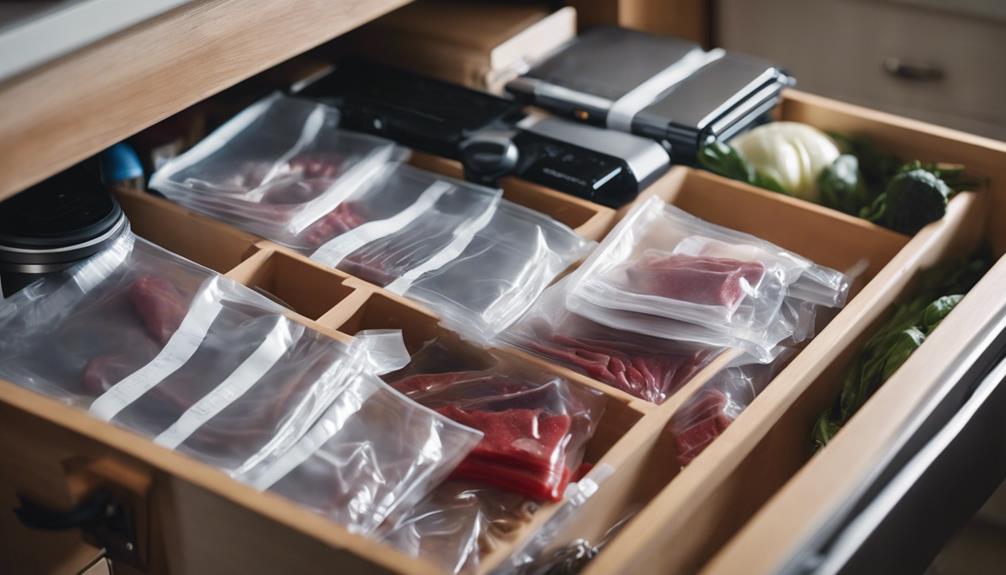
To maintain the quality and longevity of your sous vide equipment, prioritize safe storage practices. Store your immersion circulators and vacuum sealers in their original packaging when not in use to safeguard them from damage.
Keep your sous vide containers and bags in a cool, dark cupboard to protect them from sunlight, which can impact their quality. Avoid storing your equipment near heat sources or sharp objects to prevent accidents and malfunctions.
Remember to store your sous vide equipment in a clean, dry place away from moisture to safeguard against any potential damage. Regularly inspect and clean your stored equipment to guarantee proper functionality and maintain hygiene standards.
Frequently Asked Questions
How Do You Cook Sous Vide Safely?
To cook sous vide safely, guarantee proper sanitation, manage time effectively, control temperature accurately, vacuum seal food properly, prioritize food safety, maintain equipment well, and prevent cross-contamination. Share these practices for safer cooking experiences.
What Not to Do With a Sous Vide?
When cooking sous vide, common mistakes can lead to food safety risks. Avoid equipment mishaps by double-checking temperatures. Manage time wisely to prevent bacterial growth. Guarantee proper sealing to avoid cross-contamination. Maintain cleanliness for safe cooking.
What Temperature Is Unsafe for Sous Vide?
When cooking sous vide, it's essential to maintain precise control over temperatures. Keep food out of the danger zone to prevent bacterial growth. Guarantee proper insulation and take safety precautions to minimize risks associated with temperature fluctuations.
What Is a Disadvantage of Sous Vide?
Slow cooking with sous vide can lead to texture changes, affecting tenderness in delicate foods. While precision control is important for safety, extended times may alter flavors. Vacuum sealing before cooking guarantees consistent results.
Conclusion
So there you have it – 10 essential tips for safe sous vide cooking. By adhering to these guidelines, you can guarantee that your meals are cooked to perfection every time, without compromising on food safety.
Remember to always use food-grade bags, properly pasteurize your food, and follow recommended cooking times.
With a little care and attention to detail, you can enjoy delicious sous vide meals with peace of mind.
Happy cooking!
